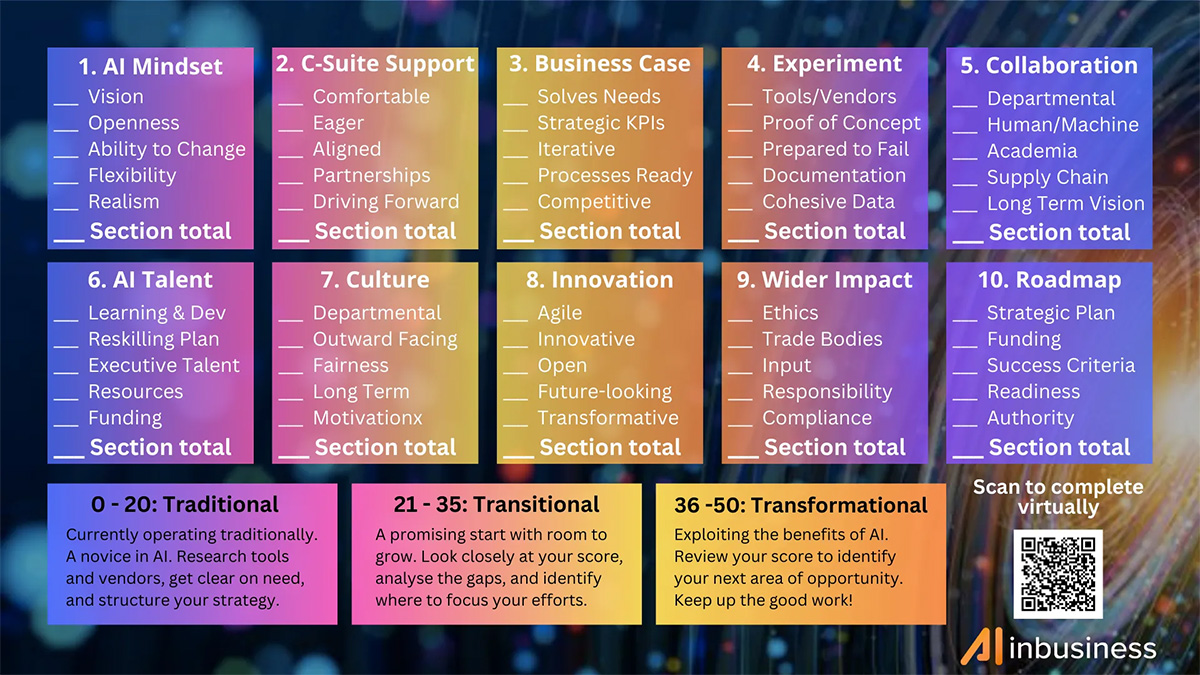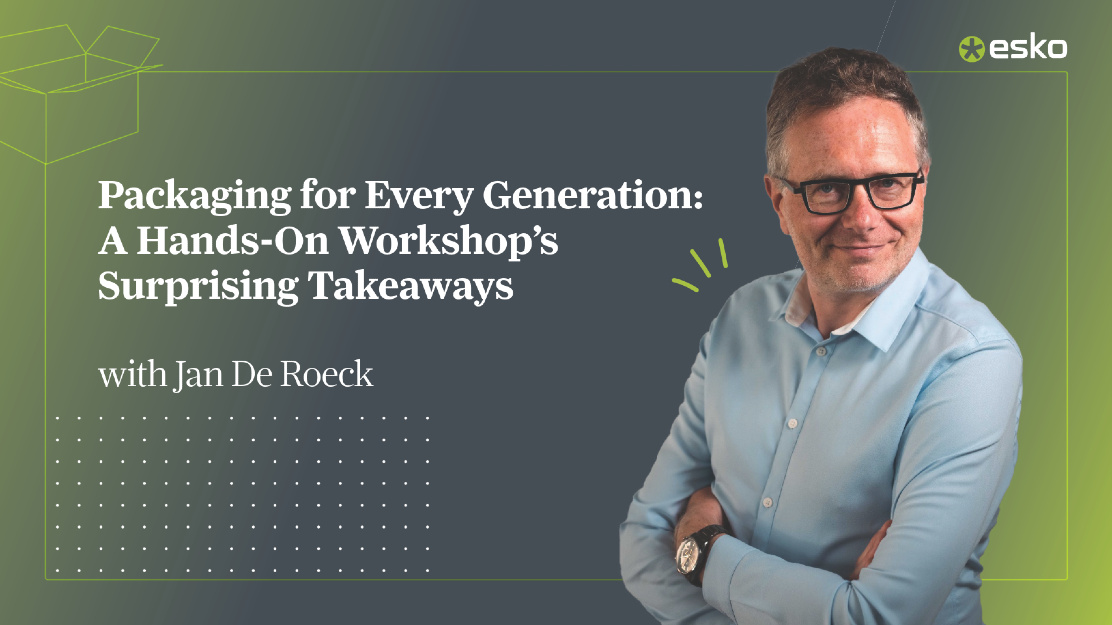Katie King, a globally recognized AI expert, author, and keynote speaker, is reshaping how businesses think about artificial intelligence. With over 30 years of experience, Katie has advised some of the world’s leading organizations, from multinational corporations to government bodies, on leveraging AI to drive innovation and growth.
Esko recently sat down with Katie to explore the profound impact AI is having on the packaging industry, from transforming artwork and design processes to ensuring compliance and enhancing customer engagement.

In this insightful conversation, Katie shares her expertise on AI’s current applications in packaging and how companies can position themselves for success both today and tomorrow in a rapidly evolving technological environment.
The Current Landscape of AI in Packaging
Esko: How is AI transforming the packaging industry, particularly in artwork, design, printing, and labeling?
Katie: AI is not yet being deployed to its full potential. Yet, I think it’s fair to say AI is the defining technology of our generation. Thus, companies that are hesitant or burying their heads in the sand must wake up now and see its far-ranging benefits.
So, if we think about AI specifically in packaging for artwork and design, there’s what we call everyday AI, which is automating repetitive tasks, enhancing creativity, improving accuracy, and predicting consumer preferences.

However, there’s not just one tool that can do all of this. So many organisations complain the current landscape is a bit like the Wild West.
To expand on that briefly, there is the paradox of personalization, which I covered in my second book. When a customer gives consent to their data being collected, organisations can give them a much more personalized experience.
They can look at clients, customers, historic activity, and demographics and can predict what their preferences and next actions are likely to be with some real accuracy. When it comes to the artwork and design, that’s important.
The Coca-Cola Company, for example, uses AI to generate dynamic bottle designs and can tailor them to specific markets. The result is a much greater increase in the engagement with their customers and brand recognition.
If you think about labelling, then you might talk about regulatory compliance, how AI is helping you by cross-referencing requirements and automating what that translation might be or detecting errors.
Pfizer, for example, is using AI to monitor pharmaceutical labels and reduce the number of errors and costly recalls.
Practical Steps to Begin Your AI Journey
Esko: For companies unsure where to start, what practical steps would you recommend to begin integrating AI into their workflows?
Katie: People are inundated with AI options and how AI can help them. What I often recommend to people is my Scorecard for Success. There are ten scorable areas, and they can achieve a maximum score of 50.
It includes questions such as “do we have the right mindset for change?” or “do we have the buy-in from the board or the management team?” It’s a good starting point for people to think about ethics, having a business plan, having a business case, thinking about their talent, and so on.

AI Benchmarks Are a Moving Target
Esko: To expand on that, have you come across or created any benchmarks or targets people should be expecting when they use AI tools?
Katie: It’s difficult to set those. Funny enough, I interviewed the head of a trade body yesterday and he said AI is just changing the rules and the nature of the way we do business. Because typically a board wants to see the ROI, but we don’t have those guarantees at the moment. AI adoption is currently following the Gartner Hype Cycle, having moved past the initial excitement and peak of inflated expectations into a phase of disillusionment. However, even though mistakes have been made, AI is increasingly being deployed across various industries, though comprehensive case studies and benchmarks of success still remain scarce.
Esko: AI is a “moving target,” Many organizations are waiting for a major breakthrough or “big thing” in AI, but the real progress will come from the cumulative impact of smaller innovations.
Katie: Exactly. AI is gradually permeating all job functions within sectors like pharma, packaging, and design, including legal and regulatory areas. It requires constant learning and adaptability. We all need to keep growing and evolving all the time because technology moves so fast.
Some Examples
Esko: Can you give an example of a company using AI successfully?
Katie: Nestlé is leveraging AI to optimize its packaging design with a strong focus on sustainability and efficiency. AI tools assist the company in analyzing product volumes and shipment sizes, enabling them to recommend recyclable materials that minimize waste. Nestlé’s goal is to achieve 100% recyclable packaging by 2025.
Some of the banks are using AI successfully as well, helping them with compliance, facial recognition scanning, and getting customer consent to data collection and then providing them with very tailored products and services.
The Five Pillars of AI Success
Esko: We’ve already discussed the scorecard, but are there any other key measures of success for companies using AI in their labeling and artwork processes?
Katie: Yes, to summarize them, I would say error reduction and time savings are massive. Cost efficiency is another one and that’s one of the big barometers of success for a lot of companies. Increased revenue, but reduced costs. In packaging, meeting global regulatory standards is really important. The final one is customer experience. Customer satisfaction is obviously one of the key measures of success.
Going back to the concept of personalization, personalized and innovative design is really important. Heineken, for example, has AI-powered smart packaging that’s enhancing consumer engagement because they’re using dynamic QR codes.
I think those five things: error reduction, time savings, cost efficiency, compliance accuracy and customer satisfaction are really important. They’re at the heart of everything we’re doing in a business: satisfying customer needs profitably. AI is having a big, big impact on that.
“Error reduction, time savings, cost efficiency, compliance accuracy, and customer satisfaction are the five pillars of AI success.”
Automation vs. AI: Understanding the Distinction
Esko: There has been discussion about automation versus AI and where the lines are drawn between the two. Do you think companies understand the distinction?
Katie: Many companies still struggle to understand the difference. In 2019, organizations were often purchasing what was marketed as AI but was, in reality, just rules-based automation. However, that is beginning to change as companies become more discerning, conduct more due diligence, and face increasing competitive pressure.
AI is a branch of data science that includes machine learning and tools capable of imitating intelligent human behavior. Automation, on the other hand, focuses on executing repetitive, rules-based tasks. It’s important not to be misled into thinking automation tools are AI. There needs to be tighter regulations to ensure transparency in how tools are marketed and sold.
Established companies like Adobe and IBM, as well as emerging tech firms, offer credible AI solutions, but choosing the right tools requires careful evaluation.
Esko: Definitely, and there is added complexity for industries like life sciences, where reliance on automation feels safer due to its predictability, while AI introduces a level of uncertainty because outcomes may change based on new data inputs.
Katie: Yes, the shift creates unease, particularly in regulatory compliance contexts, and underscores the importance of trust, quality assurance, and continuous agility in adopting these technologies.

Navigating Global Regulations: AI in Action
Esko: Speaking of compliance, could you elaborate on the evolving global legislative landscape for AI in regulated industries like life sciences?
Katie: The global legislative landscape is evolving rapidly, with a strong focus on transparency, accountability, and bias reduction. These elements are particularly critical in industries such as pharmaceuticals. For instance, the FDA in the United States has issued guidance on using AI for predictive analytics, rigorous validation, and audit trails, which are essential for maintaining regulatory compliance.
In Europe, the EMA is enforcing strict requirements for AI systems in life sciences, emphasizing error-free labeling and robust data security. The European Union has even implemented the world’s first binding law on AI, highlighting its commitment to governing these technologies. Meanwhile, the United States is focusing on algorithmic accountability—ensuring transparency in how AI decisions are made—and addressing issues like intellectual property and deep fakes through measures such as the 2024 No Fake Act and executive orders for trustworthy AI development.
Given the complexity of these evolving frameworks, companies are appointing AI ethics advisors to oversee compliance and ethical considerations. I recommend that organizations take a proactive role by collaborating with trade bodies and industry groups to contribute to shaping these regulations. For example, in the UK, I work with an all-party parliamentary group focused on enterprise adoption of AI. This initiative educates policymakers, enabling them to collaborate with industry leaders and create informed policies.
“Collaboration between academics, businesses, and regulators is essential to shape informed AI policies.”
It’s therefore essential for businesses to not only keep pace with these regulations but also actively influence them. By fostering collaboration between academics, businesses, think tanks, and regulators, we can ensure AI is deployed in a way that meets both ethical standards and industry needs.
The EU AI Act: Implications for the Packaging Industry

Esko: Would you explain more about the EU AI Act and the possible impact it may have on the packaging industry?
Katie: The EU AI Act, which came into force in 2024, categorizes AI systems based on their risk levels. High-risk systems, such as those used in the packaging and labeling sector, require transparency and clear documentation of AI’s role in decision-making processes. This ensures that these systems operate in an accountable and reliable manner.
The Act also addresses bias mitigation and data security, emphasizing the importance of producing accurate and inclusive outputs while safeguarding consumer information through strong data security measures. These considerations are particularly vital to protect consumer trust and maintain compliance.
The Act is still relatively new, and its enforcement mechanisms, including fines and detailed implementation procedures, will need to remain agile to keep pace with advancements in AI.
What’s Next? Predictions for AI-Driven Innovation in Packaging
Esko: Based on your experience and research, what do you predict will be the next major AI-driven innovation in the packaging industry?
Katie: Yes, good question. If only we could have a crystal ball! The rapid arrival and impact of generative AI already took many of us by surprise. However, I believe we will see advancements in AI-powered smart packaging, including features like dynamic QR codes and generative design tools. For example, tools like Adobe Firefly are already enabling companies to create multiple design variations efficiently.
Sustainability will also play a critical role in the near term. AI will be instrumental in optimizing materials and production methods to minimize environmental impact. Companies like Tetra Pak are using AI to develop eco-friendly packaging designs in real-time. These innovations not only address environmental concerns but also support broader goals for a more sustainable industry.
Beyond these advancements, customer experience (CX) and personalization will remain central to innovation. With AI’s ability to analyze granular persona data, sectors are increasingly putting the customer at the heart of everything they do. The emergence of agentic AI—intelligent agents capable of reasoning and assisting with decision-making—will further transform the industry to help us achieve some of the big macro goals such as sustainability and enhanced personalization.
Building Readiness for AI Success
Esko: To position themselves to get the best from AI, what additional steps should companies take?
Katie: Getting the most out of AI begins with building organizational capabilities and aligning processes effectively. This starts with training employees to work efficiently with AI tools, which I’ve supported through initiatives like AI simulation training. Through this, we can tailor training to the diverse needs of personnel, such as accommodating disabilities, different languages, or various styles of learning. Personalization in training not only improves employee skills but also deepens understanding across teams.
To implement AI successfully, it’s critical to map existing processes and identify bottlenecks. For example, companies in food packaging could reduce approval cycles by 25% through effective process mapping and integrating AI into workflows. Internal communication is equally important—ensuring alignment across teams on the benefits and objectives of AI adoption.
Lastly, I also encourage companies to use a structured approach like my Scorecard for Success, which enables them to gamify the process and keep building their skills.
“Success with AI isn’t about a magic solution but about building logical, ethical, and emotional dimensions within your organization.”
The Final Word
Esko: Thank you so much for your time, Katie, is there anything else you’d like to add before we conclude?
Katie: Success with AI isn’t about a magic solution but rather developing logical, ethical, and emotional dimensions across the organization—building trust internally and externally with clients and vendors. By focusing on small proofs of concept and aligning strategies with clear goals, companies can pave the way for impactful AI adoption tailored to their unique needs and ambitions.
Are you interested in learning more about digital solutions for the packaging industry? Get in touch with us today!




